In the beginning as you learn to use the sling, support your baby with your hands.
Do not wear your baby in your sling while you are riding in a moving vehicle. The exceptions are public vehicles such as buses, airplanes, etc. - where the sling is exceptionally useful! The sling is not a substitute for an approved car seat.
Do not use the baby sling while jogging, running, bicycling, exercising or in any sporting activity where your baby's safety could be compromised.
Do not use the baby sling while cooking, or close to an open flame, as baby's hands are fast and curious, and baby slings are flammable!
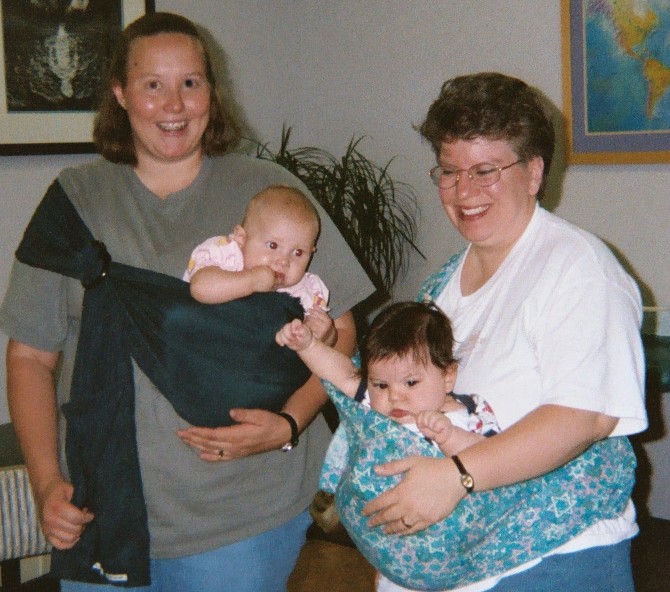
Toddlers and older babies can grab things while they are riding in the sling. Keep your distance from potential hazards.
Do not twist suddenly while wearing baby in the sling. As a precaution, practice twisting your upper body as if reaching for something and simultaneously hold you baby with your other arm.
If you need to stoop down, bend at the knees not the waist. Also, you should hold the baby with one hand while doing this.
Be careful when going through doorways or narrow hallways. Make sure that your baby does not strike walls, doorjambs or other hazards.
Do not drink hot beverages while wearing your baby but it is OK to eat and to drink cold beverages while you are carrying baby in your sling.
Please remember that your baby is not tied in. It is possible for a child to climb out of a baby sling, so do not use your sling with an uncooperative child.
Never have both hands so full that you do not have a hand for the baby in the sling.
It is your responsibility to use the baby sling safely. Learn more about safe baby wearing through online searches, in books, or from experienced sling wearing mothers.
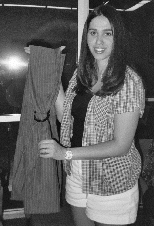 Please remember that learning to use a baby sling
will take time. Practice, patience and persistence will allow you to
learn to easily and quickly place your baby comfortably and securely
inside your sling.
Please remember that learning to use a baby sling
will take time. Practice, patience and persistence will allow you to
learn to easily and quickly place your baby comfortably and securely
inside your sling.
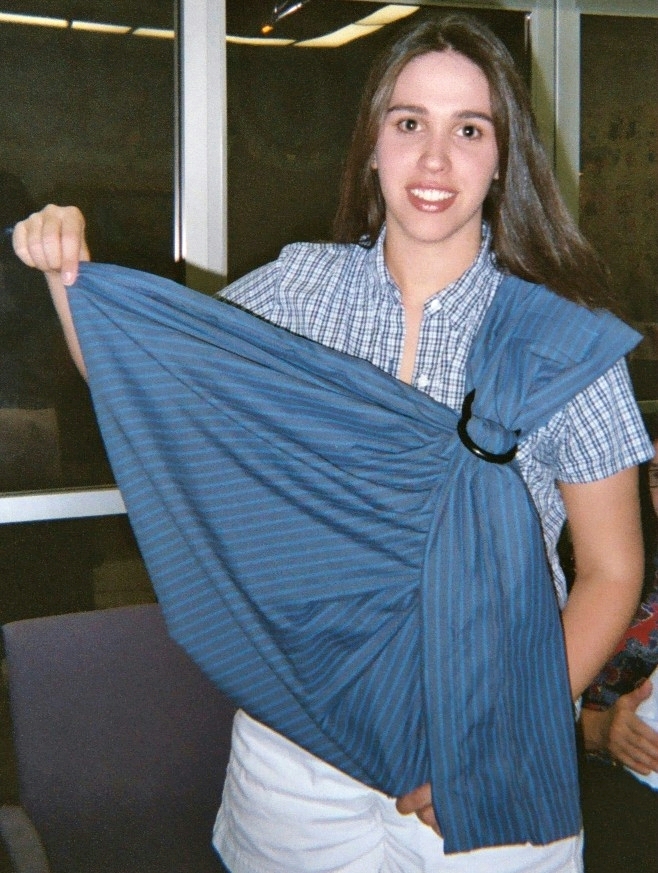 THREADING YOUR SLING:
It is very important to thread the fabric properly
through the rings. Lay your sling down with the pocket facing up.
Then take the pocket end and spread the fabric out. Take the fabric
to the right side of the pocket in your right hand, and the fabric to
the left side of the pocket in your left hand. Gather the fabric
together, working towards the center, as if you are folding up a fan.
When you reach the center, your sling should be all gathered
together. Now thread about 1/3 of the fabric up through both rings.
Fold the fabric over and loop it back through the bottom ring.
THREADING YOUR SLING:
It is very important to thread the fabric properly
through the rings. Lay your sling down with the pocket facing up.
Then take the pocket end and spread the fabric out. Take the fabric
to the right side of the pocket in your right hand, and the fabric to
the left side of the pocket in your left hand. Gather the fabric
together, working towards the center, as if you are folding up a fan.
When you reach the center, your sling should be all gathered
together. Now thread about 1/3 of the fabric up through both rings.
Fold the fabric over and loop it back through the bottom ring.
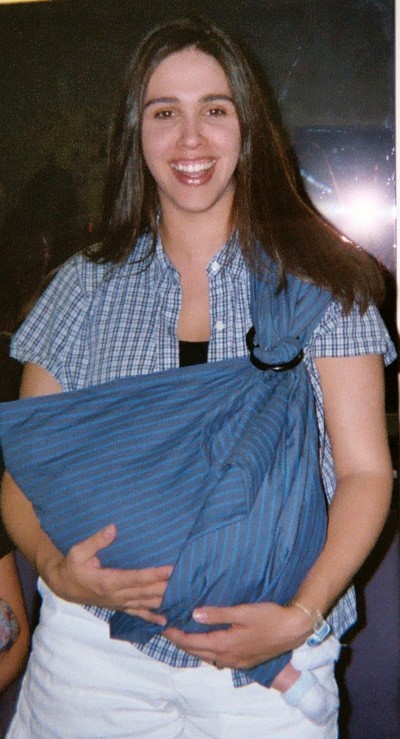 Your sling can be worn on either
shoulder. If you would like to wear the sling on your right shoulder
switch the lefts and rights in these directions. To wear this sling
on your left shoulder: Hold the rings of your sling with your right
hand. Be sure the tail is in front of the loop. Put your right arm
through the loop and bring the sling over your head. Rest the rings
in front of your left shoulder. They should rest on your collarbone,
where you would wear a corsage. It's very important that the
rings do not move from this spot, no matter what position you are
wearing your baby in.
Your sling can be worn on either
shoulder. If you would like to wear the sling on your right shoulder
switch the lefts and rights in these directions. To wear this sling
on your left shoulder: Hold the rings of your sling with your right
hand. Be sure the tail is in front of the loop. Put your right arm
through the loop and bring the sling over your head. Rest the rings
in front of your left shoulder. They should rest on your collarbone,
where you would wear a corsage. It's very important that the
rings do not move from this spot, no matter what position you are
wearing your baby in.
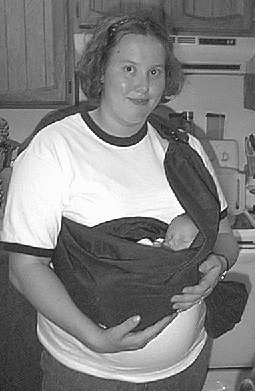 Using your sling with Newborns and Small Infants:
Whenever you place your newborn in your sling, always support your baby's
head until the sling has been tightened enough to provide support.
The most common position for nursing is when the baby's head is
opposite the rings. Depending on his/her length, the legs/thighs may
be poking out of the sling on the ring side. As you nurse, you can
completely cover yourself by placing the tail of the sling over your
shoulder. Some newborns are happier in a vertical position. Your baby
can be carried this way if you tighten the sling enough to support
your baby's head. Always wear your sling as snugly as you can
comfortably do so.
Using your sling with Newborns and Small Infants:
Whenever you place your newborn in your sling, always support your baby's
head until the sling has been tightened enough to provide support.
The most common position for nursing is when the baby's head is
opposite the rings. Depending on his/her length, the legs/thighs may
be poking out of the sling on the ring side. As you nurse, you can
completely cover yourself by placing the tail of the sling over your
shoulder. Some newborns are happier in a vertical position. Your baby
can be carried this way if you tighten the sling enough to support
your baby's head. Always wear your sling as snugly as you can
comfortably do so.
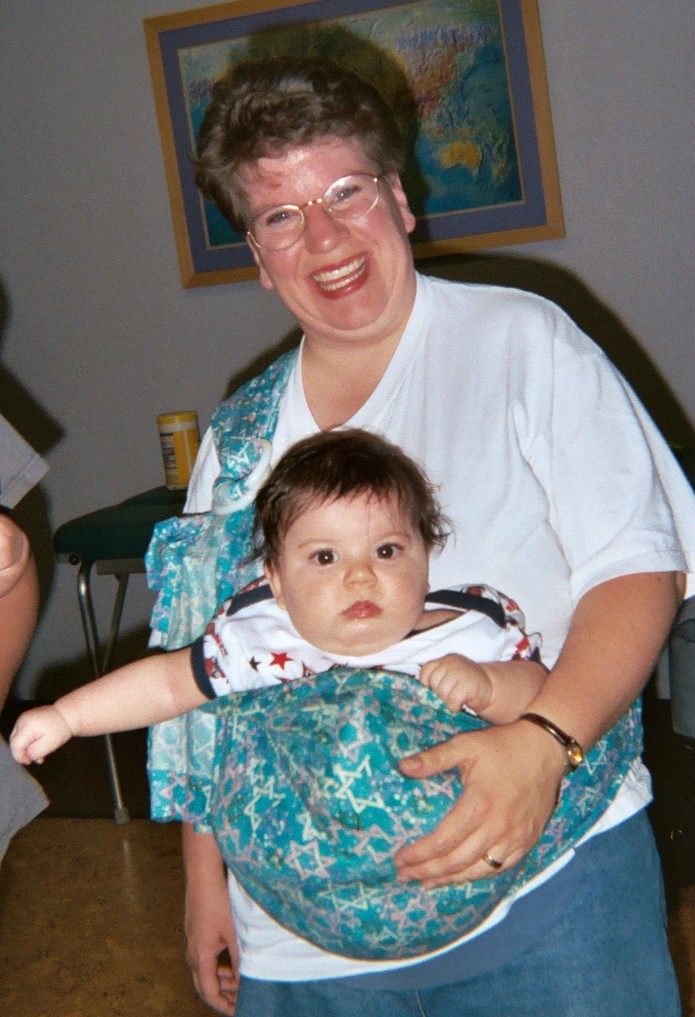 Kangaroo Carry:
This position works best with younger babies who have head
control (3-9 months, up to 18-20 lbs). Put on your sling and open the
pouch as if you were planning to put your baby in lying down. Cross
your baby's legs and place your baby in sitting up. While
supporting your baby's weight, pull on the tail to tighten the
sling.
Kangaroo Carry:
This position works best with younger babies who have head
control (3-9 months, up to 18-20 lbs). Put on your sling and open the
pouch as if you were planning to put your baby in lying down. Cross
your baby's legs and place your baby in sitting up. While
supporting your baby's weight, pull on the tail to tighten the
sling.
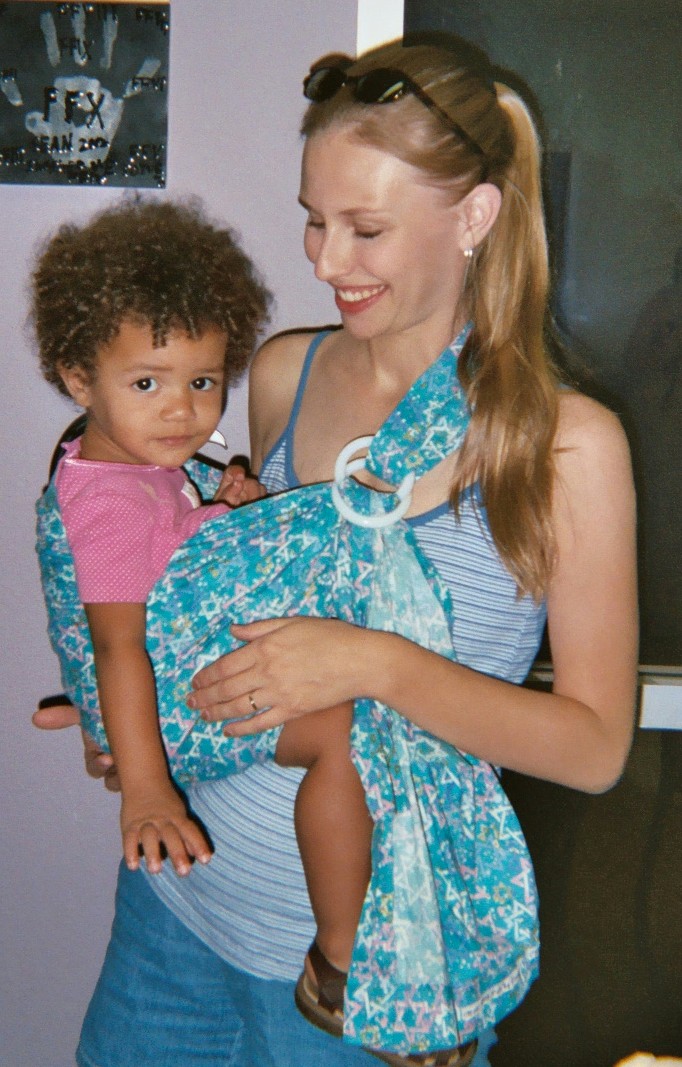 Hip Carry:
This is an excellent position for heavy toddlers (6 months
and up) because your hip is used to support your child's
weight. Put your child in your sling and rest your child on your hip
with your child's legs straddling you. The bottom of the sling
should extend out to your child's knees. The top of the sling
should come up to your child's arms.
Hip Carry:
This is an excellent position for heavy toddlers (6 months
and up) because your hip is used to support your child's
weight. Put your child in your sling and rest your child on your hip
with your child's legs straddling you. The bottom of the sling
should extend out to your child's knees. The top of the sling
should come up to your child's arms.
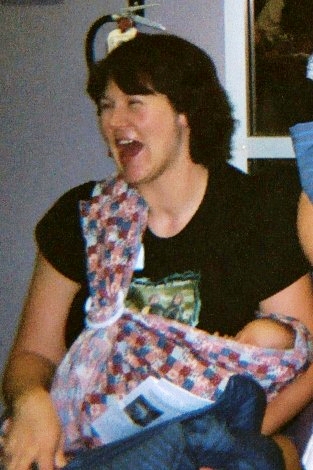 Washing Instructions
Your sling can be machine washed and dried. For best results, wash in cold water and
either line-dry or tumble dry on low.
Washing Instructions
Your sling can be machine washed and dried. For best results, wash in cold water and
either line-dry or tumble dry on low.
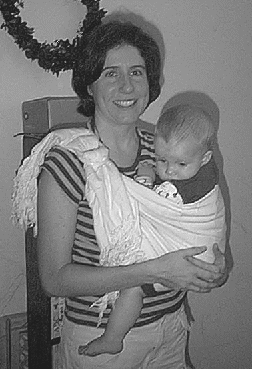 A few words about the Velcro® closure at the shoulder...
I started putting Velcro® on my slings when I first started making
slings for myself, over seven years ago. I did this for a number of
reasons, and over time I found many other benefits, a few of which
are: I prefer Sea Dog® brand nylon rings over metal rings or
wooden rings. Wooden rings break, and metal rings are, well, metal.
Which means that I had to take my baby out of the sling to go through
security checkpoints at the airport or courthouse, and if I left the
sling in the car in the summer, the sling was unusable because of the
burning hot metal rings. Sea Dog® nylon rings do not get so
burning hot, and I have never heard of one breaking. The down side
of Sea Dog® rings is that they are hard to find and relatively
expensive, and since I like to have several slings (I am including
instructions for making more slings for yourself), I put Velcro®
on the slings so I can change the rings from one sling to another.
Other advantages of Velcro® is that I never have to listen to the
rings banging around my washer and dryer, and when I use the sling at
the park or church as a blanket for my baby, I could remove the rings
and [the little kicker] would not wake himself up by kicking the
rings or banging himself. I have had the occasional question about
the safety of the Velcro® closure over just sewing the rings in,
and I guess if the sling was not worn correctly, there could be a
safety issue. However if the sling is worn with the Velcro-ed flap
on the underside at the shoulder with the rings in the "corsage
position", the Velcro® could not slip. If you are still
concerned, take a couple of diaper pins and pin the flap closed near
the Velcro®.
A few words about the Velcro® closure at the shoulder...
I started putting Velcro® on my slings when I first started making
slings for myself, over seven years ago. I did this for a number of
reasons, and over time I found many other benefits, a few of which
are: I prefer Sea Dog® brand nylon rings over metal rings or
wooden rings. Wooden rings break, and metal rings are, well, metal.
Which means that I had to take my baby out of the sling to go through
security checkpoints at the airport or courthouse, and if I left the
sling in the car in the summer, the sling was unusable because of the
burning hot metal rings. Sea Dog® nylon rings do not get so
burning hot, and I have never heard of one breaking. The down side
of Sea Dog® rings is that they are hard to find and relatively
expensive, and since I like to have several slings (I am including
instructions for making more slings for yourself), I put Velcro®
on the slings so I can change the rings from one sling to another.
Other advantages of Velcro® is that I never have to listen to the
rings banging around my washer and dryer, and when I use the sling at
the park or church as a blanket for my baby, I could remove the rings
and [the little kicker] would not wake himself up by kicking the
rings or banging himself. I have had the occasional question about
the safety of the Velcro® closure over just sewing the rings in,
and I guess if the sling was not worn correctly, there could be a
safety issue. However if the sling is worn with the Velcro-ed flap
on the underside at the shoulder with the rings in the "corsage
position", the Velcro® could not slip. If you are still
concerned, take a couple of diaper pins and pin the flap closed near
the Velcro®.